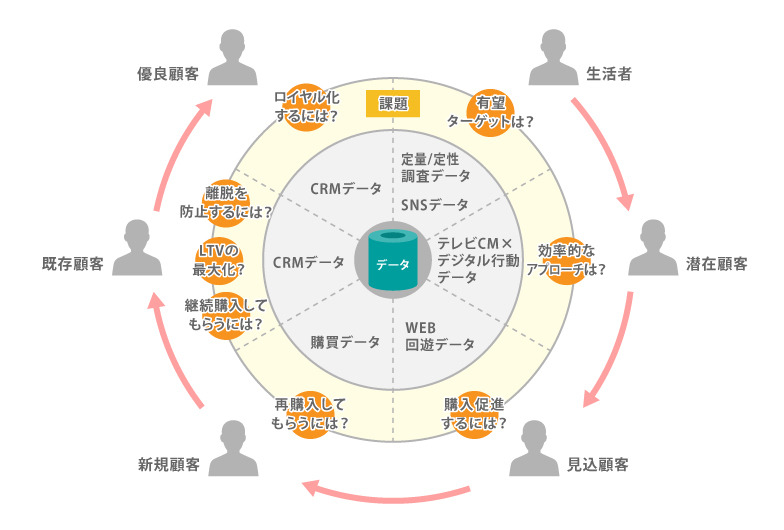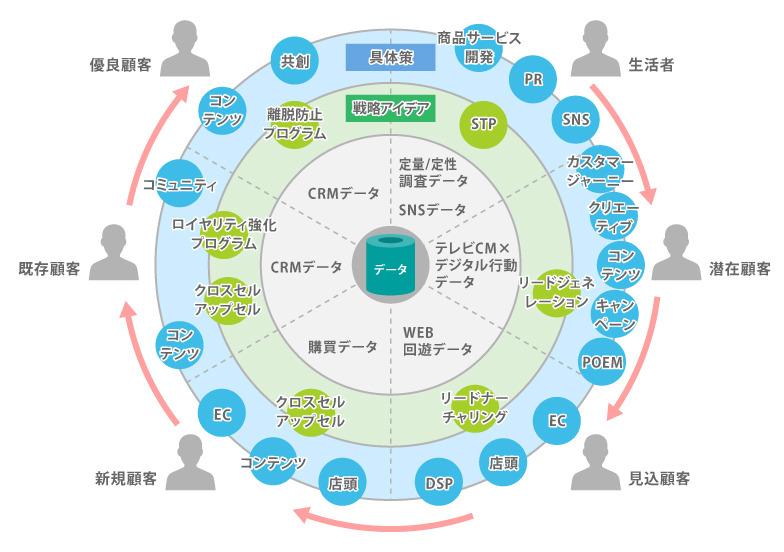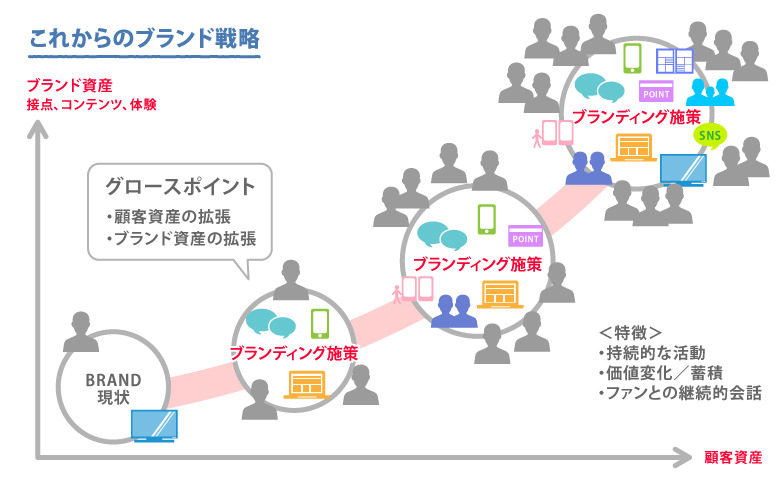Note: This website was automatically translated, so some terms or nuances may not be completely accurate.
How are you handling branding in the digital age? - Hacking the Way to Grow Your Brand -
I. The Wave of "Digital Transformation" is Surging
Recently, Fast Retailing (Uniqlo) announced plans to analyze customer big data and implement proposal-based services. The plan involves analyzing customer purchase data to understand preferences, recommend other products, and predict trends for new product development. Furthermore, shortly before that, Seven & i Holdings announced its omnichannel strategy to integrate physical and online retail. Additionally, daily goods manufacturers like Kagome are collaborating with Amazon on product development utilizing search keywords.
Thus, industries and companies that previously relied mainly on mass advertising and in-store promotions are increasingly moving toward building new customer relationships using technology and data. This shift comes as mass advertising becomes less effective amid the progress of the digital information society. Efforts to strengthen customer relationships by applying technology and data to products/services and business processes are called "digital transformation." Many companies are starting to act to respond to the digitalization of consumers, who were already ahead in areas like smartphone usage.
ⅡCMO Anxieties and Expectations in the Digital Age
Amid this transformative period, CMOs (Chief Marketing Officers) and business unit heads are grappling with the anxiety of "How should we connect with customers?" while simultaneously harboring high expectations for the "digitalization of marketing" driven by digital transformation. The digitalization of marketing brings about three major environmental shifts.
It makes it easier to collect customer behavioral data, enabling companies and customers to connect through data, leading to: ① Greater customer understanding, ② Easier connection with customers in various states (potential/prospective/new/existing customers, etc.), and ③ Easier verification of campaign effectiveness. Leveraging these three environmental changes, Dentsu Brand Growth Hack also offers three services to address CMOs' anxieties and meet expectations for marketing digitalization. ( Reference: Series Part 1 )

① Expanding Customer Assets
First, we view "business growth as increasing the number of customers and encouraging them to purchase more." We pursue the expansion of customer assets (increasing new to existing customers, encouraging more purchases, fostering continuity, etc.). With various behavioral data becoming easier to obtain, we can now visualize not only the movements of new customers acquired through mass campaigns but also the processes of converting prospects into customers and turning existing customers into high-value customers. This is creating an environment where we can track 360-degree customer trends. Consequently, it has become easier to diagnose the opportunities and challenges present at each customer phase.
② Expanding Brand Assets (Expanding touchpoints, content, and experiences)
Next, for these 360-degree customers—from everyday consumers to new customers to high-value customers—we enhance brand value by expanding digital touchpoints, providing content, and delivering new brand experiences (i.e., expanding brand assets). This involves not only mass advertising but also leveraging owned/earned media like brand websites and social media, expanding physical store touchpoints, distributing video content, and offering new services or features. In an era of information overload where mass advertising is less effective, building ongoing relationships with existing customers—especially fans—through content, and acquiring new customers via word-of-mouth on social media, is crucial for expanding customer assets. Ultimately, every company will design a unique customer journey for its 360-degree customers, blending digital and physical touchpoints. Sooner or later, a world where customers are connected through data and systems at every stage will arrive.


③ Expansion KPI Management
Within this system environment, we collect diverse customer data and establish KPIs to manage whether customer assets and brand assets are expanding smoothly. We set KPIs aligned with each phase of the 360-degree customer journey and implement PDCA cycles.
Ⅲ Building Brands in the Digital Age
Against this backdrop of marketing digitalization, a brand's worldview is being reevaluated as a guiding principle for complex and diverse marketing activities. Precisely because it's easier than ever to connect with anyone, the question "Who are the customers truly suited to this brand?" becomes even more crucial. Furthermore, precisely because we live in an era where any kind of digital content can be created, the question "What kind of content is truly suited to this brand?" becomes vital. Moreover, precisely because we live in an era where any data can be obtained and short-term effectiveness verified, it becomes even more vital to "manage the brand's future from a medium-term perspective." In other words, brands are evolving into dynamic assets that continuously adapt to the rapidly changing environment and shifts in consumer information. They do so while gently adjusting to their surroundings, preserving their core value, and continually evolving their relationship with consumers.
Traditional brand strategies tended to prioritize image and relied on one-way communication to achieve brand vision.

Moving forward, however, it is crucial to grow brands by expanding customer assets through continuous connections with diverse customers, leveraging data, technology, and systems, starting with brand fans. Simultaneously, expanding brand assets through digitally enabled touchpoints, content, and experiences is vital. Consequently, future brands will become ongoing brand activities characterized by continuous improvement, where value evolves and accumulates through sustained engagement with customers. This represents a shift from "brand activities" to "branding activities."

Consequently, the role of advertising agencies will evolve to commit to brand growth and sustainable business growth alongside CMOs. While "growth hacking" is often perceived as "leveraging advanced technical skills to solve problems," "growth contracting," or "growth tricks," we position "Brand Growth Hacking" as a service that actively utilizes data and technology to undertake brand growth and business growth through the expansion of customer assets and brand assets. The specific support broadly falls into the three areas outlined earlier in Section II: ① A service to "find" high-potential customer candidates by exploring opportunities for customer asset expansion using 360-degree behavioral data. ② A service to "nurture" these candidates into fans by expanding touchpoints, delivering content, and providing new brand experiences through digital means. ③ A service to "organize" by setting KPIs for branding activities, collecting activity data, building dashboards for PDCA cycles, and confirming the optimization of mass and digital channels and the direction of branding, with sales as the ultimate goal.
Regarding the "Find" service (①), which we introduced in the previous column, we'll defer to that article for details. Essentially, finding new customers requires capturing not just awareness data from web surveys, but also "actual behavioral data" showing what customers have actually done. This includes purchase data, TV commercial viewing data, digital behavior data, SNS data, CRM data, and more. By defining targets through granular segmentation and approaching them with digital initiatives, we now live in an era where full-fledged STP (Segmentation, Targeting, Positioning) marketing is possible, unlike the mass-media-centric past.
What follows is the next step: the phase of "nurturing" these identified potential customers. Here, we leverage digital to engage targets through new contact points, content, and brand experiences, enhancing brand equity and creating situations where people want to share. The current emphasis on content and experiences stems from their effectiveness in spreading brand experiences through digital word-of-mouth.
Digital marketing now offers diverse methods to cultivate and expand 360-degree customer assets. For potential customers, for example, we can guide them from engaging digital content on social media to the brand website, fostering positive feelings and converting them into prospects. Video is emerging as the next trend in digital content, and we expect even more diverse video formats to proliferate.
For those at the prospect level, you can build a database based on email addresses obtained through campaign sign-ups, then individually approach them with digital content to convert them into new customers. Here, using MA (Marketing Automation) technology for automated content delivery allows you to segment and deliver content tailored to individual interests and preferences, thereby increasing response rates.
To encourage repeat purchases or convert new customers into loyal ones, create personalized My Pages offering exclusive brand experiences. Collaborate with customers on service development to enhance brand loyalty. This CRM domain is prioritized for expanding customer assets. Enthusiastic fans' word-of-mouth spreads through digital channels like social media, reaching consumers and potential customers, significantly boosting new customer acquisition.
A crucial point to note here is that the above describes merely the "design of methods." To truly elicit a response from consumers and prompt action, it is essential to design emotions and motivation—calculating reactions like "What's that?", "That sounds interesting!", or "I want to tell my friends about this!" This requires the techniques for moving people (insights, motivation, creativity, etc.) that advertising agencies also implement in mass advertising. Simply implementing the mechanism won't elicit a response from consumers. It's the substance—the brand's unique content and experiences—that moves people's hearts, sparks action, and generates word-of-mouth they want to share. While ad tech efficiency matters, what becomes crucial here is how deeply each individual customer comes to love the brand.
In this rapidly changing era of digital marketing, it's not the strong or clever brands that survive, but those that can continuously adapt to their environment, much like Darwin's principle. In today's climate where mass advertising is said to be less effective, the key to business growth lies in nurturing and expanding 360-degree customer assets—moving beyond a fixation on acquiring new customers—through digital marketing. Furthermore, I believe the mainstream approach will be to continuously expand brand assets like special content and experiences while maintaining consistent branding. Supporting these activities is digital (data, technology, systems).
Next time, we'll introduce the "organizing" process—how to manage cultivated customer and brand assets using specific KPIs and link them to the next strategies and initiatives—while sharing the latest insights. Stay tuned.
Was this article helpful?
Newsletter registration is here
We select and publish important news every day
For inquiries about this article
Back Numbers
Author

Masafumi Tanizawa
Dentsu Digital Inc.
Integrated Planning Division
Business Unit Head / Innovation Director
Joined Dentsu Inc. in 2002. Since then, has participated in numerous president-level projects and CMO projects for various clients. Serves as a director handling both strategy and execution, spanning beyond advertising to include management and business strategy consulting, brand consulting, cutting-edge database marketing, and integrated campaign planning. Holds a Master of Business Administration. Planning motto: "Calculate meticulously, execute boldly!"

